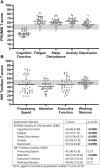Impact of sleep disruption on cognitive function in patients with postacute sequelae of SARS-CoV-2 infection: initial findings from a Neuro-COVID-19 clinic
- PMID: 38370438
- PMCID: PMC10873785
- DOI: 10.1093/sleepadvances/zpae002
Impact of sleep disruption on cognitive function in patients with postacute sequelae of SARS-CoV-2 infection: initial findings from a Neuro-COVID-19 clinic
Abstract
Introduction: Fatigue, brain fog, and sleep disturbance are among the most common symptoms of postacute sequelae of SARS-CoV-2 infection (PASC). We sought to determine the impact of sleep disruption on cognition and quality of life in patients with neurologic manifestations of PASC (Neuro-PASC).
Methods: Thirty-nine patients were recruited from Neuro-COVID-19 clinic. Mean age was 48.1 years, 71.8% were female, and 82% were never hospitalized for COVID-19. Patients were evaluated via clinical assessment, quality-of-life measures in domains of cognitive function, fatigue, sleep disturbance, anxiety, and depression, NIH Toolbox cognitive tests, and 7 days of wrist actigraphy.
Results: The median number of neurologic symptoms attributed to PASC was 6, with brain fog being the most common in 89.7%. Regarding non-neurologic symptoms, 94.9% complained of fatigue and 74.4% of insomnia. Patients reported significant impairment in all quality-of-life domains and performed worse in a task of attention compared to a normative US population. Actigraphy showed Neuro-PASC patients had lower sleep efficiency, longer sleep latency (both p < 0.001), and later sleep midpoint (p = 0.039) compared to 71 age-matched healthy controls with no PASC history. Self-reported cognitive symptoms correlated with the severity of fatigue (p < 0.001), anxiety (p = 0.05), and depression (p < 0.01). Objective evidence of sleep disruption measured by wakefulness after sleep onset, sleep efficiency, and latency were associated with decreased performance in attention and processing speed.
Conclusion: Prospective studies including larger populations of patients are needed to fully determine the interplay of sleep disruption on the cognitive function and quality of life of patients with PASC.
Keywords: COVID-19; cognition; fatigue; insomnia; long COVID; neurology; post-acute sequelae of SARS-CoV-2 infection; sleep.
© The Author(s) 2024. Published by Oxford University Press on behalf of Sleep Research Society.
Figures




Similar articles
-
Neurologic manifestations of Long COVID in Colombia: a comparative analysis of post-hospitalization vs. non-hospitalized patients.Front Hum Neurosci. 2024 Aug 13;18:1450110. doi: 10.3389/fnhum.2024.1450110. eCollection 2024. Front Hum Neurosci. 2024. PMID: 39192882 Free PMC article.
-
Plasma Biomarkers of Neuropathogenesis in Hospitalized Patients With COVID-19 and Those With Postacute Sequelae of SARS-CoV-2 Infection.Neurol Neuroimmunol Neuroinflamm. 2022 Mar 7;9(3):e1151. doi: 10.1212/NXI.0000000000001151. Print 2022 May. Neurol Neuroimmunol Neuroinflamm. 2022. PMID: 35256481 Free PMC article.
-
Plasma proteomics show altered inflammatory and mitochondrial proteins in patients with neurologic symptoms of post-acute sequelae of SARS-CoV-2 infection.Brain Behav Immun. 2023 Nov;114:462-474. doi: 10.1016/j.bbi.2023.08.022. Epub 2023 Sep 11. Brain Behav Immun. 2023. PMID: 37704012 Free PMC article.
-
The Neurological Manifestations of Post-Acute Sequelae of SARS-CoV-2 infection.Curr Neurol Neurosci Rep. 2021 Jun 28;21(9):44. doi: 10.1007/s11910-021-01130-1. Curr Neurol Neurosci Rep. 2021. PMID: 34181102 Free PMC article. Review.
-
Neurological post-acute sequelae of SARS-CoV-2 infection.Psychiatry Clin Neurosci. 2023 Feb;77(2):72-83. doi: 10.1111/pcn.13481. Epub 2022 Oct 17. Psychiatry Clin Neurosci. 2023. PMID: 36148558 Free PMC article. Review.
Cited by
-
Multidimensional Characterization of Long COVID Fatigue.Behav Sleep Med. 2025 Jun 19:1-10. doi: 10.1080/15402002.2025.2522671. Online ahead of print. Behav Sleep Med. 2025. PMID: 40537100
-
Cognition and objective sleep quality in post-COVID-19 patients.Front Psychol. 2025 Feb 3;16:1418602. doi: 10.3389/fpsyg.2025.1418602. eCollection 2025. Front Psychol. 2025. PMID: 39963680 Free PMC article.
References
-
- JHU Medicine. COVID-19 Dashboard by the Center for Systems Science and Engineering (CSSE) at Johns Hopkins University & Medicine. https://coronavirus.jhu.edu/map.html.Accessed September 21, 2022.
Grants and funding
LinkOut - more resources
Full Text Sources
Miscellaneous

